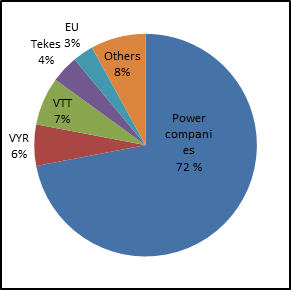FINLAND
(Updated 2013)
1. GENERAL INFORMATION
1.1. Country overview
1.1.1. Governmental system
Finland is a parliamentary democracy with a multiparty political system and a president as the head of state. Finland declared itself independent on 6 December 1917. Since independence, Finland has lived with Western democracy intact and has become a member of the European Union.
Power in Finland is vested in the people, who are represented by the parliament. At the local level, Finland is divided into municipalities which elect local councils.(1)
1.1.2. Geography and climate
Finland (in Finnish Suomi) is a republic in northern Europe, bounded on the north by Norway, on the east by Russia, on the south by the Gulf of Finland and Estonia, on the southwest by the Baltic Sea and on the west by the Gulf of Bothnia and Sweden. Nearly one third of the country lies north of the Arctic Circle.
The area of Finland, including 31,557 km2 of inland lake area, totals 338,000 km2. The terrain is generally level, hilly areas are more prominent in the north and mountains are found only in the extreme northwest.
The average (1971-2000) July temperature in the capital Helsinki on the southern coast is 17.2 (C. The February average in Helsinki is about -4.9 (C. The corresponding figures at Sodankylä (Lapland) in northern Finland are 14.3 (C and -12.7 (C. Precipitation (snow and rain) averages about 460 mm in the north and 640 mm in the south. Snow covers the ground for four to five months a year in the south, and about seven months in the north.
In Finland, the total primary energy consumption per capita was about 88% higher than the European Union (EU27) average (according to OECD 2009 statistics).(2) This is mainly due to the weather, which demands space heating for most of the time, and the structure of the industry, which is energy intensive process industry (wood, especially paper, heavy metal and chemical). A third factor is relatively high transportation requirements per capita caused by the low population density
1.1.3. Population
Finland has a population of 5.43 million and an average population density of 17.8 per km2 of land. Historical population data is shown in Table 1. The annual population growth rate between the years 2000 and 2012 is 0.39 %. More than two thirds of the population reside in the southern third of the country.
TABLE 1. POPULATION INFORMATION
| Average annual growth rate (%) | |||||||
| Year | 1970 | 1980 | 1990 | 2000 | 2005 | 2012 | 2000 to 2012 |
| Population (millions) | 4.6 | 4.9 | 5.0 | 5.2 | 5.2 | 5.43 | 0.39 |
| Population density (inhabitants/km²) | 15.1 | 15.7 | 16.4 | 17.0 | 17.2 | 17.8 | 0.38 |
| Urban population as % of total | 50. 3 | 59.8 | 61.4 | 61.1 | 62.4 | 63.4 | N/A |
| Area (1000 km²) | 304.6 | ||||||
Source: Statistics Finland (http://www.stat.fi/tup/suoluk/suoluk_vaesto_en.html)
1.1.4. Economic data
Of the factors that will influence economic growth in the decades ahead, the easiest to anticipate is population ageing, which will depress labor supply and hence reduce the economy’s growth potential. In contrast, it is much harder to estimate future trends in productivity. The slower productivity growth since 2008 could be viewed as a temporary phenomenon that will be followed by a return to the earlier trend of rapid productivity growth, but it could also be a more permanent change. In any case, the share of output taken by services, with their slower productivity growth, will grow in the immediate decades ahead as the population ages, which foretells a much more sluggish GDP over the next few decades.(3)
TABLE 2. GROSS DOMESTIC PRODUCT (GDP)
| Average annual growth rate (%) | |||||||
| Year | 1975 | 1980 | 1990 | 2000 | 2005 | 2012 | 2000 to 2012 |
| GDP (millions of current US$) | 29,177 | 53,101 | 139,218 | 121,912 | 196,133 | 255,066 | 6.3 |
| GDP (millions of constant 2000 US$) | 62,990 | 73,603 | 99,575 | 121,912 | 138,931 | 144,512 | 1.4 |
| GDP per capita (PPP* US$/capita) | N/A | 9,336 | 18,252 | 28,476 | 35,780 | 46,459 | 4.2 |
| GDP per capita (current US$/capita) | 6,181 | 11,091 | 27,852 | 23,530 | 37,319 | 47,123 | 6.2 |
* PPP: Purchasing Power Parity
December 2000: 1 € = 0.898 US$. December 2012: 1 € = 1.3116 US$.
Source: OECD – Purchasing Power Parities (http://stats.oecd.org/Index.aspx?datasetcode=SNA_TABLE4#)
Source: Statistics Finland (http://tilastokeskus.fi/til/vtp/2012/vtp_2012_2013-03-01_tau_001_fi.html)
Source: Statistics Finland (http://www.stat.fi/tup/suoluk/suoluk_kansantalous_en.html)
1.2. Energy information
1.2.1. Estimated available energy
Finland is highly dependent on foreign energy supplies. Crude oil and oil products constitute a major part of imported energy. Other main fuels imported to Finland are coal and natural gas. Finland imports all of its oil, natural gas, coal and uranium. The primary indigenous energy resources in Finland are hydro power, wood, wood waste, pulping liqueurs and peat. The peat resources are about 800–1000 Mtoe (34–42 EJ) and reserves are estimated at 280 Mtoe. These could be exploited with an annual rate of 4.0–4.7 Mtoe for about 60 years. The use of wood and wood based fuels in 2012 was 0.32 EJ (7.6 Mtoe) corresponding to almost 25% of the total primary energy consumption. Unexploited hydropower reserves have been estimated to correspond to an annual production of the order of up to 9.5 TWh. However, most of the unharnessed river areas are either nature reserves, frontier rivers or tiny waterfalls. Economically significant additional hydro power potential until 2020 could be about 0.6 TWh.
Table 3 below shows estimated domestic energy sources with certain restrictions. Most of presented figures are rough estimations based on eligible energy production in 2020 and are taken from the national energy and climate strategy 2013 baseline scenario. Fossil fuels here include only peat since it is the only domestic fossil fuel source available in Finland. As mentioned in the paragraph above, Finnish peat resources are vast but according to energy and climate strategy, peat production in 2020 will be significantly lower compared to the existing potential. Increase in use of wood chips (total production in 2020 was 25 TWh) in CHP –applications and in distance heat production will partly offset future peat and other fossil fuel consumption. Estimation on this expected progress can be seen in table 3 ‘other renewables’ which includes only wood based fuels and wind power production. Wind power capacity is based on 2020-estimations foretelling 2500 MW installed capacity and yearly production of 0.02 EJ (6 TWh), while wood based fuels take a fair share amounting 0.35 EJ per year (98 TWh). Hydro power capacity in table 3 includes only power and efficiency upgrades of current capacity. Again, potential is somewhat more considerable but only a part of this potential capacity can be harnessed for energy production purposes. The National Energy Strategy 2020 baseline scenario figure for hydro power production is 0.05 EJ per year (14 TWh), while upgrading capacity is estimated to be somewhere around 260 MW. Uranium resources are 15,800 tons (estimated recoverable resources) and include only Talvivaara Nickel-Zinc mine. Uranium by-production and estimated uranium production of Talvivaara mine could be up to 350-500 tons per annum.
TABLE 3. ESTIMATED AVAILABLE ENERGY SOURCES
| Estimated available energy sources | ||||||
| Fossil Fuels | Nuclear | Renewables | ||||
| Solid | Liquid | Gas | Uranium | Hydro | Other Renewables | |
| Total amount in specific units* | 5.9 | 0 | 0 | 15,800 | 3.3 | N/A |
| Total amount in (EJ) | 0.06 | 0.05 | 0.37 | |||
* Solid: Million tons; Uranium: Metric tons; Hydro, Renewables: GW
Renewables (for a period of 10 years)
Source: Ministry Of Employment and the Economy – Energy and Climate Strategy 2013 Report
(http://www.tem.fi/files/36279/Kansallinen_energia-_ja_ilmastostrategia_taustaraportti.pdf)
1.2.2. Energy statistics
Finland's energy mix is diverse and well balanced, and many of its power plants can be optimised for up to three different fuels. About 2.5 million inhabitants (slightly less than half) lived in district heated apartments and about 69 % of all district heat was produced in 2012 in CHP plants, and in total CHP covered about 27 % of Finland’s electricity demand in 2012.
Total demand for primary energy in 2012 was 32.7 Mtoe (1368 EJ) and the different energy sources used are given in table 4. The long-term trend of energy supply from 1970 onwards is depicted in figure 1 and the trend in final energy consumption in different sectors in figure 2. In 2012 peat production decreased by 22 % (due to production shortages) which in turn increased use of wood based fuels and also coal. Hereby wood based fuels covered almost one-fourth of total energy consumption which equals to annual oil consumption. Otherwise natural gas consumption reduced by 11 % and nuclear power production by 1 %.
TABLE 4. ENERGY STATISTICS
| Average annual growth rate (%) | |||||||
| (Values in Exajoules (EJ = 10¹8 J) | 1970 | 1980 | 1990 | 2000 | 2005 | 2012 | 2000 to 2012 |
| Energy consumption* | |||||||
| -Total | 0.72 | 0.95 | 1.14 | 1.32 | 1.37 | 1.37 | 0.3 |
| -Solids (Coal, Peat) | 0.10 | 0.19 | 0.22 | 0.21 | 0.20 | 0.20 | -0.6 |
| -Liquids (Oil) | 0.41 | 0.46 | 0.38 | 0.36 | 0.36 | 0.33 | -0.6 |
| -Gases (Natural Gas) | 0.00 | 0.03 | 0.09 | 0.14 | 0.15 | 0.12 | -1.7 |
| -Nuclear | 0.00 | 0.07 | 0.20 | 0.24 | 0.24 | 0.24 | 0.2 |
| -Hydro (Incl. Wind Power) | 0.03 | 0.04 | 0.04 | 0.05 | 0.05 | 0.06 | 1.1 |
| -Others | 0.01 | 0.01 | 0.01 | 0.02 | 0.02 | 0.04 | 8.0 |
| -Other Renewables (Wood Based Fuel) | 0.17 | 0.14 | 0.17 | 0.27 | 0.28 | 0.32 | 1.4 |
| Energy production | |||||||
| -Total | 0.21+ | 0.29 | 0.51 | 0.63 | 0.70 | 0.71++ | 1.1 |
| Net import (Import - Export)** | |||||||
| -Total | 0.002 | 0.004 | 0.039 | 0.043 | 0.061 | 0.063 | 3.2 |
* Energy consumption = Primary energy consumption + Net import (Import - Export) of secondary energy
** Electricity net import
+ OECD 1971 statistics
++ OECD 2011 preliminary statistics
Source: Statistics Finland (http://www.stat.fi/til/ehk/2012/04/ehk_2012_04_2013-03-22_tie_001_fi.html)
Source: OECD Energy production
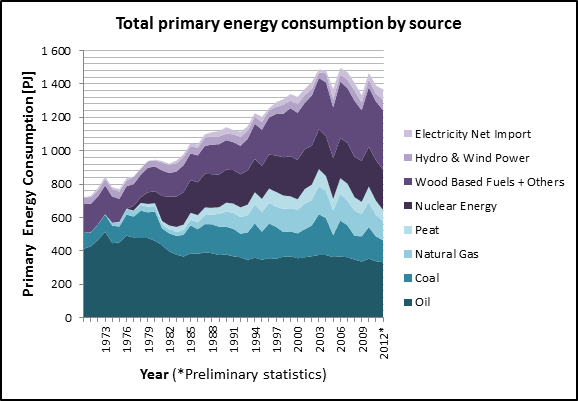
FIG 1. Total primary energy consumption in Finland by source 1970-2012(4)
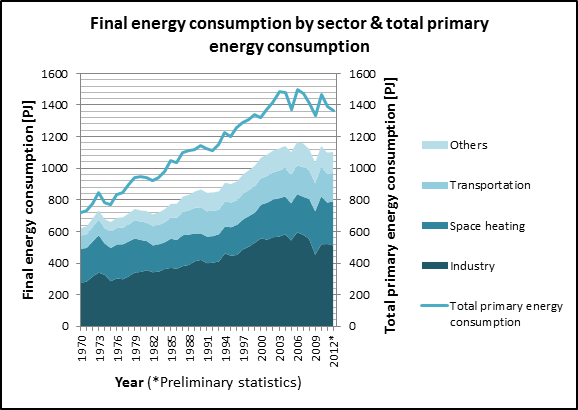
FIG 2. Final energy consumption in Finland by source 1970-2012(5)
1.2.3. Energy policy
The objectives of Finnish energy policy are: security of supply; effective energy markets and economy; environmental acceptability and safety. In Finland, energy supply decisions on energy systems take place at a fairly decentralised level – with the exception of nuclear power. A substantial proportion of energy is imported and produced by private enterprises. The energy companies with majority ownership by state are also run on a purely commercial basis.
In 1994, Finland ratified the Framework Convention on Climatic Change. For the reference year (1990) of the convention, the total CO2 -emissions in Finland were 56.59 million tons and the total emission of greenhouse gases (GHG) 70.36 Mt CO2 eq. In the Kyoto Protocol to the Framework Convention on Climatic Change the EU commitment is to reduce greenhouse gas emissions, calculated as an average of the emissions between 2008 and 2012, by 8 % from the 1990 level. According to the burden sharing between the EU countries, Finland’s commitment is to return the emissions to the 1990 level. Meeting the emission limits – especially those of CO2– would be a challenging task to be accomplished without the expanded use of nuclear power and renewable energy sources. The long-term trend in CO2 -emissions is depicted in figure 3. In years 1991 to 1993 the GHG emissions decreased slightly below the level in 1990 and were also slightly below that reference level in 2000, when hydro power production and net electricity imports had a large share in electricity production. On the other hand, in 2003 the CO2 -emissions from fuel combustion were the highest (30 % above the reference level) due to a record low hydro power production in Finland since 1970 and very much lower net electricity imports. The main actions aimed to restrict the emissions growth have been increasing the use of wood-based fuels, natural gas, a substitute for coal, as well as upgrading the capacity of nuclear power plants (NPP). Energy conservation has also played a role. The total GHG emissions reached an all-time peak level in 2003. During 2005 the total consumption of energy decreased considerably owing to the six-week paper industry dispute and exceptionally mild weather conditions. Furthermore, the quantity of energy produced from coal was low and the imported electricity increased clearly. Owing to these coincident factors the total GHG emissions in 2005 temporarily returned to the level of the reference year 1990. During 2009, the economic recession brought the emissions to an even lower level, but during 2010 the CO2 -emissions from energy production increased by 15.3 %.
During 2012, total energy consumption decreased by 2 % but electricity consumption increased by 1.1 % compared with 2011. Energy consumption decreased in transportation and industrial sectors by 2 %, while the space heating sector increased its energy consumption over 6 %. Electricity net import increased by 26 %, which together with decreased use of fossil fuels and wider use of renewable energy sources decreased CO2 -emissions by 8 % (figure 3). In 2012 the share of renewable energy sources accounted for 30 % of total energy consumption according to the preliminary data for year 2012. Energy end-use increased by 1 % in 2012. Industry accounted for 46 % of energy end use, which is slightly less compared with 2011. Space heating accounted for one-fourth of energy end use, which is mainly due to cold weather in 2012.
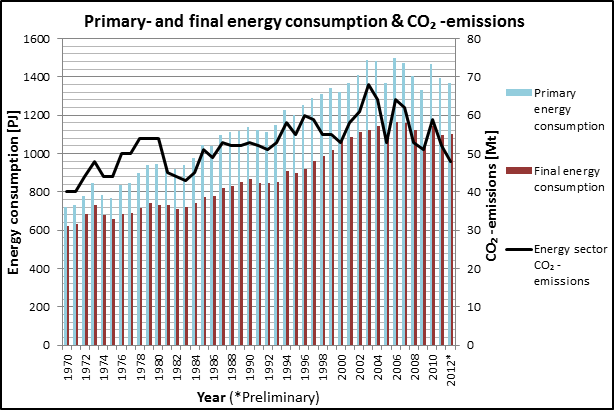
FIG 3. Primary energy and final energy consumption & CO2 -emissions 1970-2012(6)
In November 2008, the Government’s report to the Parliament on Climate and Energy Strategy was issued. A new update of the strategy is now (2013) being discussed in the parliament. The report presents the Government’s outlines for energy and climate policy in the forthcoming years, alongside proposals for key measures for the attainment of the EU’s objectives regarding the promotion of renewable energy, the enhancement of efficiency in energy consumption, and decreasing gGHG emissions.
According to the trend outlined in the strategy, the share of indigenous energy, and that of renewable energy in particular, will increase markedly over current levels. The share of renewable energy will increase to 38 % of total final energy consumption, the efficiency of the energy system will improve, and GHG emissions will begin to fall on a permanent basis. Furthermore, the share of coal and oil on the Finnish energy balance sheet will decrease, and the diversity of the domestic energy system will further improve, while the risk to the energy supply posed by crises originating outside Finland will diminish. To an extent, the energy system would be based on greater use of electricity than before.
The strategy presents two scenarios: (1) The baseline in compliance with current measures and development, and (2) the objective, meeting the EU’s and national objectives.
According to the scenarios (2013 scenario figures inside parentheses), for 2020, electricity consumption would, at the baseline be 103 TWh (94 TWh). During recent years electricity consumption has settled into a lower-than-expected growth trend due to the economic recession, structural change in the forest industry and the intensely growing efficiency of electricity consumption in households and services. Thus, the National Energy and Climate Strategy 2013 anticipates lower level of electricity consumption to be met in 2020 with recently decided actions. Estimation of primary energy consumption is 479 TWh (433 TWh), final energy consumption 347 TWh (325 TWh) and GHG emissions 89 Mt CO2-eqv. (~65 Mt) and corresponding emissions outside the emission trading sector, 36 Mt CO2 -eqv. (29.7 Mt). Concerning primary energy consumption, the target probably cannot be reached. This is partly due to changes in statistics resulting in wrong estimation of energy consumption for 2020.
According to the objective, in 2020, electricity consumption will equal 98 TWh (94 TWh), primary energy consumption 430 TWh (433 TWh), final energy consumption 310 TWh (317 TWh) (note changes in statistics regarding 2013 scenario primary and final energy consumption) and emissions outside the emission trading sector 30 Mt CO2 -eqv. (27 Mt). Emissions within industries included in emission trading are specified in accordance with EU –wide emission trading, which is under modification. In the vision for 2050 the total GHG emissions are aimed to be reduced by at least 80 % of the 1990 level of 70.4 Mt CO2 -eqv.
Figure 4 presents the forecasted electricity consumption by sectors up to year 2030 according to Confederation of Finnish Industries and Finnish Energy Industries, and by the Ministry of Employment and the Economy (MEE) in November 2009.
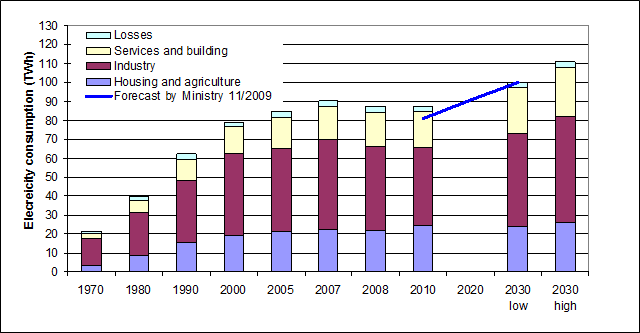
FIG 4. Electricity consumption during 1970-2010 and electricity demand up to2030 estimated by the industry (Confederation of Finnish Industries and Finnish Energy Industries, 2009) and by the Ministry of Employment and the Economy in November 2009
The goal of the Energy and Climate Strategy of 2008 is to increase the share of renewable energy to 38 % by 2020, which is in-line with the obligation proposed by the Commission for Finland. This is a challenging obligation, and its attainment fundamentally depends on having final energy consumption enter a downward trend. Finland’s natural resources would facilitate the additional use of renewable energy, but in order to realize this, the current subsidy and steering systems must be rendered more effective, and structures changed. Indeed, meeting such an obligation would require an intense increase in the use of wood-based energy, waste fuels, heat pumps, biogas and wind energy. As a new promotional method, a cost-effective feed-in tariff system, operating on market terms as far as possible, will be introduced.
1.3. The electricity system
1.3.1. Electricity policy and decision making process
The starting point for electricity sourcing is access to sufficient and moderately priced electricity with good security of supply, so that electricity sourcing simultaneously supports other climate and energy policy goals. The high share of energy-intensive industry, and the long lighting and heating season are characteristic of the Finnish electricity consumption structure. In the future, electricity sourcing will continue to be based on a versatile system based on several energy sources, diversified thanks to the cogeneration of power and heat. Domestic production capacity will be able to provide for peak consumption and possible import disturbances.
In constructing its own capacity, priority will be given to plants that do not emit GHG, or ones with low emissions, such as CHP plants using renewable fuels, and financially profitable and environmentally acceptable hydro and wind power plants. Furthermore, preparations have been performed for constructing additional nuclear power.
1.3.2. Structure of electric power sector
The Finnish power system (figure 5) consists of power plants, the main grid, regional networks, distribution networks and end-users of electricity. The system is a part of the interconnected Nordic power system together with the systems in Sweden, Norway and Denmark. Moreover, there is a direct current connection from Russia to Finland, enabling connection between the systems, which apply different principles, and also enabling power trading across the border. There is also a DC connection to Sweden under the Gulf of Bothnia and a link to Estonia. Furthermore, a new 800 MW /500 kV direct current electricity transmission connection between Finland and Sweden (Fenno-Skan 2) started commercial operation at the end of 2011.
Regional and distribution network activities are the responsibility of the electric utilities, which are licensed to operate their networks by the pertinent authority. Electricity transmission is priced using a so-called point-tariff system (postage stamp). The user can procure electricity from anywhere in the country without restriction. The user pays one grid transmission fee at his grid connection point, which covers the transmission costs for the use of the entire grid, without any additional fees. The producer can feed power into the network using the same payment principle. The grid operators are responsible for operating, maintaining and developing their networks. The transmission of electricity over the national grid as well as the boundary interconnections with Sweden, Norway and Russia are managed by a system responsible grid company Fingrid Plc., which is owned by the two major producers (Fortum and PVO), Finnish government and institutional investors.
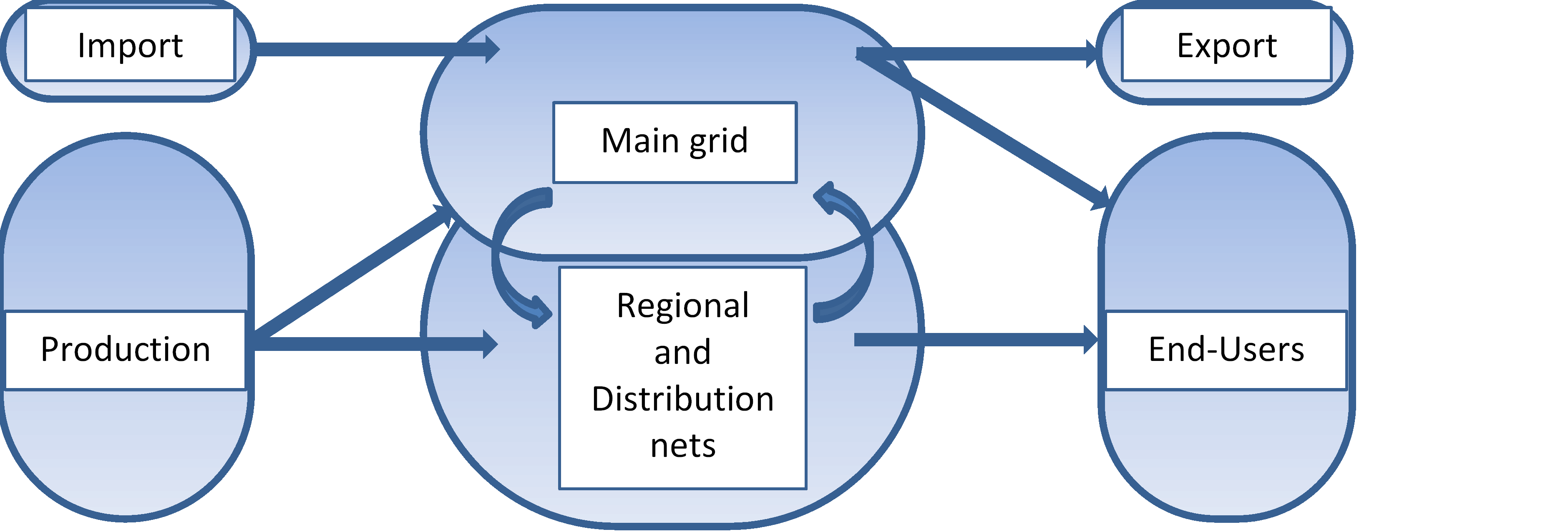
FIG 5. The Finnish power system
Energy supply in Finland is highly competitive and both the state-owned, municipality-owned and private sector energy and electricity supply utilities operate essentially on the same commercial basis as the industry in general. The Finnish power system is widely decentralised and has a diverse organisation. The main types of ownership are: (i) partly privatised, state-controlled power companies; (ii) industrial companies, and (iii) municipal and other distribution companies.
There are about 400 power plants in Finland and about half of these are hydroelectric. Fortum Power and Heat Oy is the largest power producer in Finland. Industry and its electricity producing firms together have a share of approximately the same size. The rest of power is produced by the local and regional energy companies. In addition, Finland imports electricity from Russia, the Nordic electricity markets and from Estonia to satisfy its remaining energy requirements.
The biggest bulk seller of electricity in Finland is Fortum Power and Heat Oy. It sells electricity directly to large, business-to-business customers and electricity retailers. Electricity retail is carried out mainly by the local and regional electrical companies. There are about one hundred of these players in Finland. No special permits are required to sell electricity, so the industry is open to new competitors as well.
Industrial and domestic consumers are free to use the power supplier they prefer. The power industry is covered by the same laws as other commercial activities. Companies are fully responsible for their economic operations. The main government influence on energy decisions is through taxes and some minor subsidies. Anyone has the right to construct a power station or a transmission line. Licence for construction of power plants is needed only for nuclear and hydropower plants. New power plant projects (nuclear facilities and thermal power plants (> 300 MWth)) and high-voltage transmission lines (= 220 kV)) need to undergo environmental impact assessment procedure. The construction of a transmission line requires a licence from the Energy Market Authority and a cross-border transmission line requires a licence from the MEE. The licence of electricity imports has been abolished. This deregulation has made it possible for Finnish electricity consumers to co-operate directly with foreign power producers and traders. The state promotes the use of renewable energy and conservation measures by giving some investment subsidies or other forms of support.
The decision-making process for building nuclear facilities is rather complex and requires (besides the normal environmental impact assessment procedure necessary for major power plant projects) ultimately also the approval of the Decision-in-Principle (DIP) by the Parliament. The Nuclear Energy Act of 1987 defines the procedures required for new NPPs irrespective of private or state ownership. The same is true for other nuclear facilities, such as the waste management facilities, and to decommissioning.
Fortum
Fortum is a leading energy company in the Nordic countries and other parts of the Baltic Rim. Fortum’s activities cover the generation, distribution and sale of electricity and heat, the operation and maintenance of power plants as well as energy related services. Fortum Power and Heat Oy is engaged in nuclear energy activities. In addition to the Loviisa NPP, Fortum owns minority shares in the Olkiluoto NPP and the Swedish Forsmark and Oskarshamn NPPs. Fortum Corporation was listed on the Helsinki Exchanges in December 1998. The State presently owns around 51% of its shares. In 2012, the sales of the Fortum Group amounted to about €6,200 million, power generation totalled 51.6 TWh, out of which the share of nuclear power was 32 %. At the end of 2012, the company employed around 10,400 people, out of which the share of staff in Finland was about 2,600 persons.
TVO
Teollisuuden Voima Oyj was founded in 1969 by a number of Finnish industrial companies with the purpose of building and operating large power plants. TVO produces electricity for its shareholders on a production cost basis at the Olkiluoto NPP in Eurajoki and at the Meri-Pori coal-fired power plant. TVO’s principal task is to secure economical, safe and environmentally friendly electricity generation for its shareholders at Olkiluoto’s current plant units. The company’s objective is to keep the plant units as good as new and in good condition, and to ensure the development of the personnel’s expertise.
TVO has six shareholder companies and three share series:
A. existing units (OL1 & 2)
B. the Meripori coal-fired plant and
C. the new reactor unit under construction (Olkiluoto 3)
TVO forms part of the PVO Group, whose parent company is Pohjolan Voima Oy. The power produced by TVO is delivered to the shareholders at production cost basis (so called Mankala principle). In 2012, the company’s net sales amounted to € 347 million and it sold 14.9 TWh of electricity. TVO had an average of around 879 permanent employees. The DIP for Olkiluoto 4 reactor unit was made by the Government in early May, 2010 and ratified by the Parliament at the beginning of July, 2010.
SHAREHOLDERS (%) IN DIFFERENT SHARE SERIES OF TVO
| A series (OL1 & OL2) | B series (OL3) | C series (Meri-Pori) | |
| Total | 100 | 100 | 100 |
Fennovoima
Fennovoima Oy is a new Finnish nuclear power company established in 2007 that aims to construct a new 1500 2500 MW NPP in Finland to produce power cost-effectively to its 60 Finnish share-holding companies. The operation of the plant is scheduled to begin by the end of this decade. Fennovoima will produce electricity for its owners’ needs at production cost basis (Mankala principle). Each owner will receive the share of capacity proportional to its ownership in the company. Owners of Fennovoima include enterprises in industry, trade and services, as well as regional and local energy companies. With its 34 % share, the nuclear expert E.ON Kärnkraft Finland was a minority shareholder in the company. Majority owner Voimaosakeyhtiö SF bought this share in 2013 and is planning to have deepened cooperation with Russian Rosatom.
Fennovoima has conducted the Environmental Impact Assessment procedure for three sites and the DIP including two site alternatives, Simo and Pyhäjoki in northern Finland, was made by the Government in early May 2010 and ratified by the Parliament at the beginning of July 2010. Later Fennovoima chose greenfield site Pyhäjoki to be the location of their new plant.
Posiva
Posiva Oy is responsible for the characterisation of the site for the final disposal of spent fuel and, at later date, the construction and operation of the final disposal facility. In addition, Posiva’s line of business includes other expert services in the field of nuclear waste management, provided for the two owner companies and other customers. In 2012, Posiva employed around 104 people working in the field of nuclear waste management. Posiva utilises not only Finnish expertise in the field but also contracts international research institutes. Research connected with nuclear waste management is carried out in universities, research institutes and consulting companies representing expertise in different fields. Posiva is owned by TVO (60%) and Fortum Power and Heat Oy (40%). The company had a turnover of some € 67.3 million in 2012 and is headquartered in Olkiluoto in the municipality of Eurajoki.
1.3.3. Main indicators
The main sources of power production in Finland are thermal, nuclear and hydropower plants. In 2012, the shares of these sources in the domestic power production were 42.2 %, 32.6 % and 24.5 %, respectively. So far only a very small volume (about 0.6 %) of total electricity consumption is produced by wind power, although the relative increase of wind power capacity has recently been quite rapid. Finland’s electricity generation capacity (peak load) totaling at the beginning of 2012 about 13,250 MW is illustrated in table 6. In addition, electricity is imported from Russia, the Nordic electricity market and Estonia.
The historical trends of electricity supply and the installed capacities are given in table 6. The total domestic electricity production in 2012 was 67.7 TWh and the total consumption of electricity was 85.2 TWh. In the industry sector electricity is the main source of energy. In 2012, the Finnish industry consumed 39.9 TWh (46.9 %) of the electricity. Compared with 2011 the consumption of electricity by the industry decreased 1 TWh (2.6 %). The most important industry branch is pulp and paper production, which in 2012 consumed 51.3 % of the total electricity needs of the industry and constructing. Other significant branches are the metal and chemical industries.
TABLE 5. ELECTRICITY PRODUCTION, CONSUMPTION AND CAPACITY
| Average annual growth rate (%) | |||||||
| 1970 | 1980 | 1990 | 2000 | 2005 | 2012 | 2000 to 2012 | |
| Capacity of electrical plants, gross (GWe) | |||||||
| -Thermal | 2.60 | 7.13 | 8.47 | 11.54 | 12.09 | 11.02 | -0.38 |
| -Hydro | 2.13 | 2.50 | 2.68 | 2.96 | 3.04 | 3.11 | 0.43 |
| -Nuclear | 0 | 1.11 | 2.39 | 2.76 | 2.78 | 2.86 | 0.30 |
| -Wind | 0 | 0 | 0 | 0.04 | 0.08 | 0.20 | 15.10 |
| -Geothermal | N/A | N/A | N/A | N/A | N/A | N/A | N/A |
| -Total | 4.,73 | 10.74 | 13.54 | 17.30 | 17.99 | 17.19 | -0.05 |
| Electricity production, net (TWh) | |||||||
| -Thermal | 11.86 | 21.97 | 22.71 | 31.17 | 31.70 | 28.57 | -0.72 |
| -Hydro | 9.43 | 10.12 | 10.75 | 14.45 | 13.43 | 16.59 | 1.15 |
| -Nuclear | 0 | 6.63 | 18.13 | 21.58 | 22.36 | 22.07 | 0.19 |
| -Wind | 0 | 0 | 0 | 0.08 | 0.17 | 0.49 | 16.80 |
| -Total (1) | 21.29 | 38.71 | 51.60 | 67.28 | 67.66 | 67.72 | 0.05 |
| Total electricity consumption (TWh) | 21.82 | 39.92 | 62.33 | 79.16 | 84.67 | 85.15 | 0.61 |
(1) Electricity transmission losses are not deducted
Source: Statistics Finland (http://193.166.171.75/database/statfin/ene/ehk/ehk_fi.asp)
Source: Statistics Finland (http://pxweb2.stat.fi/database/StatFin/databasetree_en.asp)
The type of power supply for 1975-2012 is depicted in figure 6 and regarding year 2012 in details in figure 7. In Finland, peak demand occurs during cold winter days and raise electricity import accordingly since domestic electricity production cannot cope with highest peak demand. In recent years, domestic electricity production has covered more than 80 % of demand. Nuclear power production is running constantly as base load and load factors are kept on a high level through well planned maintenance.
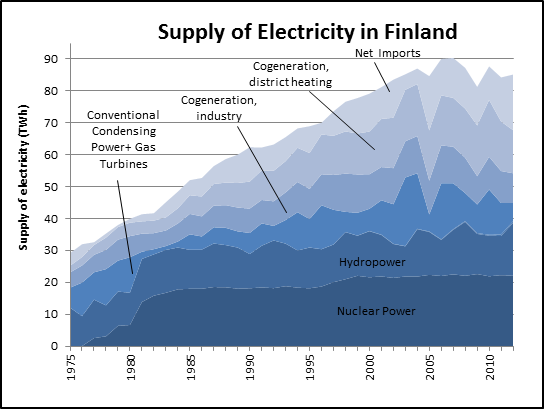
FIG 6. Electricity Supplies in Finland (1970–2012)(7)
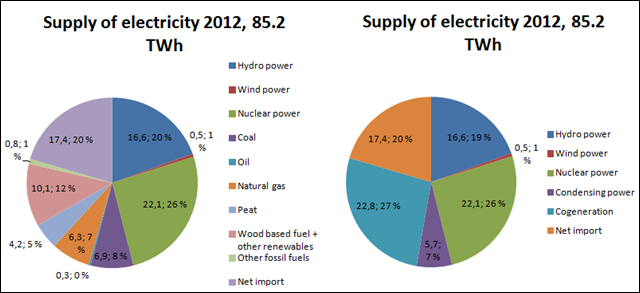
FIG 7. Electricity supply by energy sources and type of generation in Finland 2012(8)
High proportion of energy-intensive process industries and high requirements for space heating and long transportation distances make the total energy consumption per capita in Finland one of the highest in the OECD area. In 2012, the primary energy consumption per capita in Finland was 252 GJ and electricity consumption per capita 15,692 kWh. Ever higher energy consumption per capita has faced a slight downturn during the economic recession and it might be difficult to draw conclusion of near future development of consumption. External dependency on electricity has risen since the opening of the Nordic electricity market and partly due to the delayed Olkiluoto 3 NPP start-up. Originally, the fifth NPP was supposed to start operation in 2009, but latest estimations on start-up go as far as 2016. Nevertheless, the ratio of external dependency on electricity fluctuates on a yearly basis according to the whole Nordic electricity market situation which is influenced by many factors, such as emission trading scheme and the huge water reservoirs of Sweden and Norway. The historical energy statistics are given in Table 6. Energy production figures are provided by OECD database.
TABLE 6. ENERGY RELATED RATIOS
| 1970 | 1980 | 1990 | 2000 | 2005 | 2012 | |
| Energy consumption per capita (GJ/capita) | 157 | 198 | 228 | 255 | 261 | 252 |
| Electricity consumption per capita (kWh/capita) | 4,745 | 8,338 | 12,471 | 15,278 | 16,111 | 15,692 |
| Electricity production/Energy production (%) | 36.5+ | 48.1 | 36.4 | 39.1 | 34.8 | 34.3++ |
| Nuclear/Total electricity (%) | 0 | 16.6 | 29.1 | 27.3 | 26.4 | 25.9 |
| Ratio of external dependency (%) (1) | 0.3 | 0.5 | 3.4 | 3.2 | 4.5 | 4.6 |
| Ratio of external dependency (%) (2) | 70.9 | 79.1 | 79.8 | 73.1 | 73.6 | 69.1 |
+ OECD 1971 production figure
++ OECD 2011 preliminary production figure
(1) Electricity net import/Total energy consumption
(2) Electricity net import + Imported fuel/Total energy consumption
Source: Statistics Finland (http://pxweb2.stat.fi/database/StatFin/ene/ehk/ehk_en.asp)
Source: OECD statistics
2. NUCLEAR POWER SITUATION
2.1. Historical development and current organizational structure
2.1.1. Overview
The Technical Research Centre of Finland (VTT) has a research reactor in operation since 1962. The Loviisa Power Plant units, on the southern coast, owned by Fortum Power and Heat Oy (Fortum), were ordered in 1969 and 1971 and started commercial operation in 1979 and 1981. The Olkiluoto Power Plant units, on the western coast, owned by Teollisuuden Voima Oyj (TVO), were ordered in 1972 and 1974 and started commercial operation in 1979 and 1982. The Loviisa power plant has two Russian (Soviet) VVER (PWR) reactors and Olkiluoto power plant has two Swedish BWRs. At the start of the operation the nominal net capacity of the Loviisa units was 420 MW(e) each and the initial net rating of the Olkiluoto units was 660 MW(e) each. The power level (net) of the Olkiluoto units was raised to 710 MW(e) in 1984. In the connection of the latest operating licence renewal process and plant modernisation projects (cf. Section 2.2.2), the authorities approved in 1998 the uprating of the power production capacities (net) of the Loviisa and Olkiluoto plants up to 2 ( 488 MW(e) and 2 ( 840 MW(e). Thereafter the capacity of the reactor units at Olkiluoto have further been raised up to 860 MW(e) each during 2005–2006 through the modernization of the high-pressure turbines. In addition, the net capacity of Olkiluoto 1 was increased to 880 MW(e) from July 2010 onwards in further turbine improvements. Similar improvement was done for unit 2 in the connection of the maintenance outage of 2011.
The nuclear steam supply system (NSSS) and twin turbine generators for Loviisa NPP were supplied by V/0 Atomenergoexport of the former USSR. Imatran Voima Oy, IVO (predecessor of Fortum Power and Heat Oy) acted as its own architect engineer and co-ordinated the design and supply of equipment from several countries. This included the integration of West German instrumentation and, under Westinghouse licence, an ice condenser containment system.
The Olkiluoto units were ordered on turnkey contracts from Asea-Atom (now Westinghouse Electric Sweden Ab). TVO had the responsibility for the second unit's civil engineering systems. In 1993, the containment buildings were retrofitted with a Siemens filtered venting system.
According to the Nuclear Energy Act, the Government must consider whether the use of nuclear energy is in line with “the overall good of society”. In Finland, the nuclear power initiatives must come from industry. The Finnish State does not participate in the financing of nuclear projects. As stipulated in the Nuclear Energy Act, an Environmental Impact Assessment (EIA) process must be carried out in Finland before an application for a DIP can be submitted to the Government.
The Government submitted a new long-term climate and energy strategy to Parliament in November 2008, and the Parliament accepted it in June 2009. The strategy included the possibility of the establishment of a new nuclear facility even during the present administration. In 2010, the two new DIPs were based to the national energy needs in 2020 and the new strategy. In 2013, in the renewed energy and climate strategy the new projects still play an important role. This strategy is now being debated in the Parliament.
2.1.2. Current organizational chart(s)
The current organizational chart is introduced in paragraph 3.1.2. Licensing process.
2.2. Nuclear power plants: Overview
2.2.1. Status and performance of NPPs
In 2012, 25.9 % of the total electricity supply in Finland was produced by nuclear power. Finland's four operating NPP units (table 7) have a total net capacity of 2,752 MW(e) at the end of 2012. Location of operating, under construction and planned NPPs and other facilities are shown in figure 8.
NPP units have operated reliably and complied with existing safety and environmental protection standards. For years, the annual load factors of all the units have been around 90%. Both companies have invested a lot to keep the annual outages as short as possible. Loviisa 1’s low load factor in year 2012 (table 8) was caused by a longer than usual comprehensive maintenance period (which is required every 8th year).(9) The outage lasted 54 days, which was 15 days longer than planned. In addition, there were three unplanned production stoppages for unit 1.
TABLE 7. STATUS AND PERFORMANCE OF NUCLEAR POWER PLANTS
| Reactor Unit | Type | Net Capacity [MW(e)] |
Status | Operator | Reactor Supplier |
Construction Date |
First Criticality Date |
First Grid Date |
Commercial Date |
Shutdown Date |
UCF for 2012 |
| LOVIISA-1 | PWR | 496 | Operational | FORTUMPH | AEE | 1971-05-01 | 1977-01-21 | 1977-02-08 | 1977-05-09 | 84.9 | |
| LOVIISA-2 | PWR | 496 | Operational | FORTUMPH | AEE | 1972-08-01 | 1980-10-17 | 1980-11-04 | 1981-01-05 | 92.0 | |
| OLKILUOTO-1 | BWR | 880 | Operational | TVO | ASEASTAL | 1974-02-01 | 1978-07-21 | 1978-09-02 | 1979-10-10 | 90.9 | |
| OLKILUOTO-2 | BWR | 880 | Operational | TVO | ASEASTAL | 1975-11-01 | 1979-10-13 | 1980-02-18 | 1982-07-10 | 97.3 | |
| OLKILUOTO-3 | PWR | 1600 | Under Construction | TVO | AREVA | 2005-08-12 | 2016-01-01 |
| Data source: IAEA - Power Reactor Information System |
UCF (Unit Capability Factor) for the latest available year (only applicable to reactors in operation)
+ Date, when first major placing of concrete, usually for the base mat of the reactor building is done
++ Date of the first connection to the grid
+++ Estimated shutdown date
Source: Fortum (www.fortum.fi), Tvo ( www.tvo.fi)
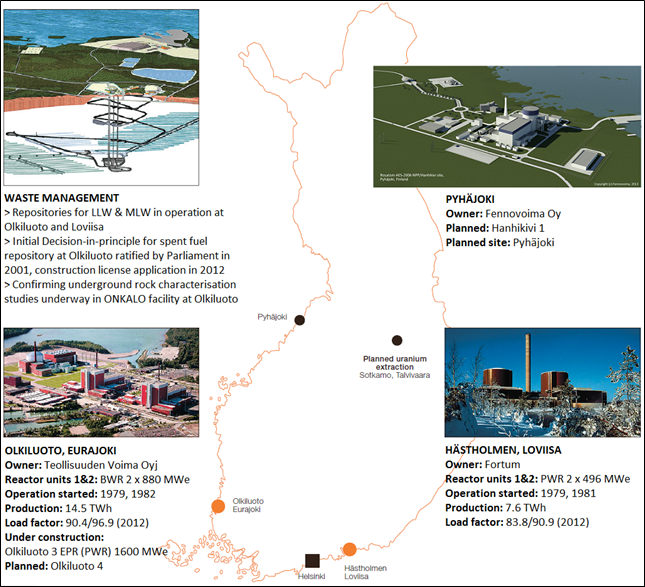
FIG 8. Map of operating and planned nuclear facilities in Finland
The historical trend of annual and cumulative load factors of the Finnish NPPs are shown in figures 9 & 10.
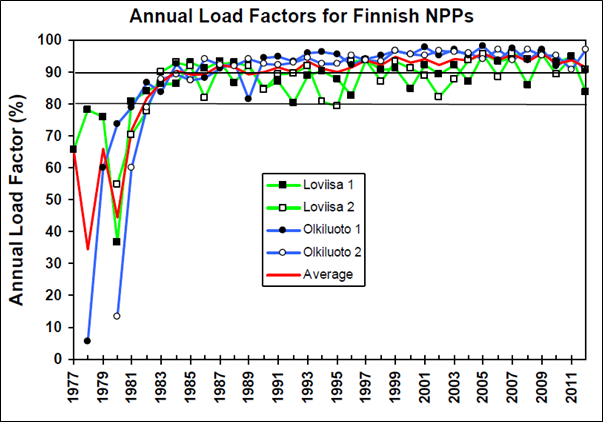
FIG 9. The development of annual load factors of the Finnish NPPs(10)
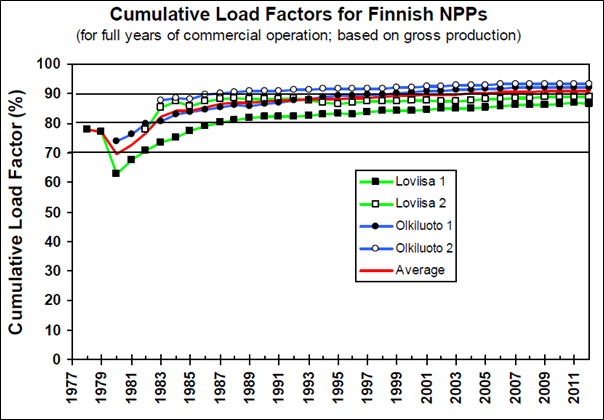
FIG 10. The development of cumulative load factors (from the beginning of commercial operation) of the Finnish NPPs(11)
The development of annual occupational collective doses (manSv/a/reactor) of the Finnish NPPs (both with 2 reactor units) are shown in figure 11, where the annual occupational doses of the Finnish nuclear power stations (1977 -2012) are compared with the authority limits. The regulatory limit for annual occupational dose is 2.5 manSv/GWe (average over two consecutive years, separately for each reactor unit).
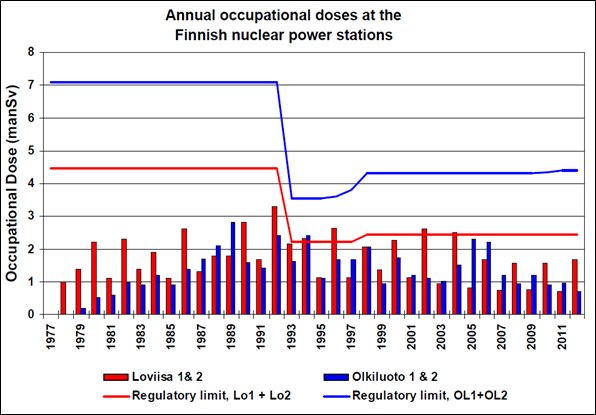
FIG 11. The annual occupational doses of the Finnish nuclear power stations (1977 -2012) are compared with the authority limits. The regulatory limit for annual occupational dose is 2.5 manSv/GWe (average over two consecutive years, separately for each reactor unit)(12)
The annual number of abnormal event (1970–2012) according to the INES-scale is depicted in figure 12 showing the total annual number of abnormal events (anomalies & incidents) according to the International Nuclear Events Scale (INES) at the Finnish NPPs during their operational history. During 2012, there were three events at the Loviisa NPP rated in category INES 1 and two events in category INES 1 at the Olkiluoto NPP.
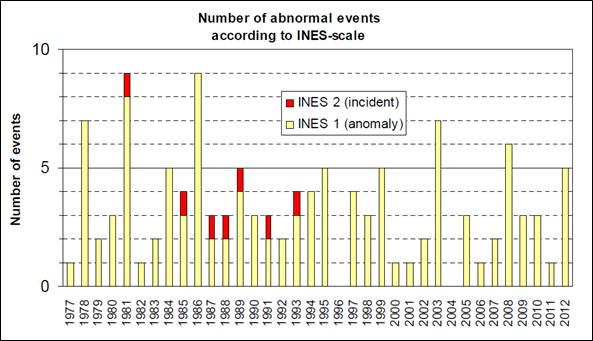
FIG 12. The total annual number of abnormal events (anomalies & incidents) according to the INES at the Finnish NPPs during their operational history.(13)
2.2.2. Plant upgrading, plant life management and license renewals\
Major modernisation and power uprating actions have been carried out in the connection of the licence renewal processes. Several technical modifications at the plants and thorough updating of the Final Safety Analysis Reports were necessary.
The upgrading of NPP capacity in 1997–1998 was altogether 350 MWe. Thereafter smaller capacity upgrading has been achieved for the Olkiluoto plant units by renewals of the turbine systems.
In April 1998 the Government granted the licence to the Loviisa 1 and 2 plant units at the uprated power level. The licence was valid up to the end of 2007. It covered also the repository for low and medium level nuclear waste and interim storages for spent fuel including the necessary expansion of these facilities. The licence for the operational waste repository is valid until the end of 2055. The thermal power of both Loviisa units was uprated to 109% from the rated power specified in the former operating licence.
Since the operating licences of the Loviisa 1 & 2 reactor units would have expired at the end of 2007, the operating licence renewal application was submitted to the authorities for a regulatory review in the autumn of 2006 and, in July 2007, the Government granted the renewal of the operating licences of Loviisa 1 & 2 up to 2027 and 2030, respectively.
As part of the automation renewal (LARA project), the I&C systems of the plant will be renewed gradually; there will be four stages per plant unit. The first system commissioning took place in 2007 and the last stage will be carried out in 2014.
The application in late 1990s for the renewal of the operating licence of Olkiluoto NPP was made for a 115.7% uprated reactor power. The Government granted the licence to Olkiluoto 1 and 2 units in August 1998 at the uprated power level. Thereafter, the capacity of the reactor units at Olkiluoto have further been raised up to 860 MWe each during 2005–2006 through the modernization of the high-pressure turbines.
The current operating licences of Olkiluoto 1 & 2 are valid until 2018 and required a comprehensive periodic safety review (PSR) in 2008. This PSR was submitted to the Radiation and Nuclear Safety Authority (STUK), for its approval. TVO began preparations for the PSR in 2004. STUK reviewed during 2009 the documentation provided by TVO and gave some recommendations to TVO in its final review report published in 2010.
TVO has also replaced the low-pressure turbines of unit 1 during 2010 and thereby raised the output of the reactor unit to 880 MW. During the 2011 maintenance outage, the capacity of unit 2 was raised similarly to 880 MW. Furthermore, TVO has preliminary plans to increase capacity further, up to 2 x 1000 MW, in connection with the application for the renewal of the operation licence required after 2018.
2.3. Future development of nuclear power
On 6 May 2010, the Finnish Government made two DIPs in favor of additional construction of nuclear power. TVO’s application for constructing a new NPP unit, Olkiluoto 4, in Eurajoki, and Fennovoima Oy’s application for constructing a new power plant in Simo or Pyhäjoki were both approved. In September 2011, Fennovoima chose Pyhäjoki for its site. The Government gave a negative DIP on Fortum’s application for constructing a new NPP unit, Loviisa 3. On 1 July 2010, the parliament ratified both DIPs.
2.3.1. Nuclear power development strategy
According to the Nuclear Energy Act, the Government must consider whether the use of nuclear energy is in line with “the overall good of society”. In 2010, the two new DIPs (table 9) were based to the national energy needs in 2020 and the 2008 strategy. In 2013, the renewed Energy and Climate Strategy maintained that the new projects still play a crucial role.
TABLE 8. PLANNED NUCLEAR POWER PLANTS
| Station/Project Name | Type | Capacity | Expected Construction Start Year |
Expected Commercial Year |
| Hanhikivi 1 | ABWR, VVER | 1200-1600 MW | 2016 | Early 2020s |
| Olkiluoto 4 | EPR, ABWR, ESBWR, APWR or APR-1400 | 1450-1650 MW | 2016 | Early 2020s |
Source: TVO (http://www.tvo.fi/Plant%20alternatives)
Source: Fennovoima (http://www.fennovoima.fi/en/hanhikivi-1-project)
2.4. Organizations involved in construction of NPPs
Information not provided.
2.5. Organizations involved in operation of NPPs
The operation, maintenance, and training at Loviisa is carried out by FPH. TVO takes care of the operation and maintenance and the operator training for Olkiluoto.
2.6. Organizations involved in decommissioning of NPPs
No NPP decommissioning has been carried out in Finland so far and the earliest NPP decommissioning is expected to take place in the early 2030s. Nuclear power operators are exclusively responsible for the decommissioning process and the final phase of NPP’s lifecycle will be funded through State Nuclear Waste Management Fund. However, the research reactor FIR-1 (TRIGA in Espoo) is now starting decommissioning and this will form a model for the bigger reactors. MEE and STUK are now developing the legislation and other measures based on this project.
2.7. Fuel cycle including waste management
After joining the European Union, the requirements of EURATOM have been adopted in nuclear fuel supply to the Finnish NPPs.
Until the late 1990's, the fuel to the Loviisa NPP came from the Russian supplier. Then the operator FPH (Fortum Power and Heat) started efforts for acquiring an optional fuel supplier from western sources besides the Russian fuel supplier. Together with the Hungarian Paks utility, test fuel assemblies have been bought from the BNFL (British Nuclear Fuels Ltd). First lead assemblies from BNFL were loaded in Loviisa in 1998 and from 2001 until 2005 part of the fuel for Loviisa NPP was delivered by the BNFL.
Uranium for TVO 1 and TVO 2 comes (or has come) from Canada, Australia, Niger, China and Russia. Most of the enrichment has taken place in Russia, the rest in Western Europe. Fuel elements delivered to Olkiluoto have been manufactured by ABB Atom in Sweden, Siemens in Germany and GENUSA in Spain.
Plans for Prospecting and Mining for Uranium in Finland
Finnish bedrock contains uranium, and its abundance in some places appeals to exploring companies. Owing to recent uranium price hikes, international uranium prospecting companies have shown interest in Finland. Environmental impact assessment procedure is applied to all uranium mining projects, without any limitations on the annual amount of the extracted resource or on the area of an opencast mine.
In addition to the licensing based on the Mining Act and on other legislation (Environmental Protection, Nature Conservation, Protection of Wilderness Reserves, Land Use and Building, Occupational Safety and Health, Radiation), production of uranium or thorium also needs a license from the Government according to the Nuclear Energy Act.
MEE promotes the use of mineral resources by securing a favourable operating environment for mineral exploration and mining activities. The Ministry has been responsible for the revision of the mining legislation in recent years. The new Mining Act was accepted by the Parliament on 15 March 2011 and entered into force on 1 July 2011. An amendment of the Nuclear Energy Act was included as well.
While securing the preconditions for mining and exploration, the Mining Act of 2011 takes account of environmental issues, citizens’ fundamental rights, landowners’ rights and municipalities’ opportunities to influence decision-making. One of the changes is that the duties of the mining authority are transferred from the Ministry to a lower administrative level, the Safety Technology Authority (Tukes). Responsible for granting permits and supervising compliance with legislation, this new mining authority office of Tukes has been established at Rovaniemi, northern Finland.
In the Mining Act of 2011, an exploration license is required for uranium exploration (e.g. drilling, trenching). Permit applications concerning a uranium mine under the Mining Act and Nuclear Energy Act are handled jointly and decided on in a single decision by the Government. The mining license for a uranium mine requires that the mining project activities are aligned with the overall interests of the society, the municipality in question has given its consent, and safety requirements are being complied with.
For the moment, Mawson Energi AB, the Swedish subsidiary of Mawson is the only active uranium exploration company in Finland and its main target presently is the Rompas Au U prospect at Ylitornio, northern Finland.
Operated by Talvivaara Mining Company Plc., the Talvivaara Ni-Zn-Cu-Co mine in Sotkamo, eastern Finland, is one of the largest sulphide nickel deposits in Europe. The company applies bioheapleaching to extract the metals from black schist-hosted ore. Although the average uranium grade is very low (0.0017%), the pregnant leach solution contains 15 to 25 mg/l U, sufficient for exploitation. Talvivaara released its plans to build a solvent extraction circuit for by-product recovery of uranium in 2010. Annual uranium production is expected to be about 350 to 500 tU. Proceeding with construction and operation of the uranium circuit requires a number of permits from the regulators. Planning, environmental impact assessment and licensing took place in 2010 to 2011. The environmental impact assessment procedure was completed in March 2011. The company filed in an application for Government license. It was granted in March 2012 and the activities are intended to start in 2013.
Cameco Corporation is providing technical assistance to Talvivaara in the design, construction, commissioning and operation of the uranium extraction circuit. Cameco and Talvivaara signed agreements in February 2011 for an up-front investment to cover the construction costs, and for purchase of the uranium concentrates produced at Sotkamo until 2027.
Waste management
Spent fuel from the reactors is stored for a few years in the fuel pools at the reactor buildings. Thereafter, spent fuel elements are transferred to interim spent fuel storage at the power plant sites. FPH and TVO are responsible for the management of spent fuel from NPPs in Loviisa and Olkiluoto. A specialised company, Posiva, which is jointly owned by the nuclear power companies TVO (60%) and FPH (40%), is taking care of the necessary R&D activities, design and implementation of the spent fuel disposal project of its owner companies. In the future Posiva also aims to supply similar design services for the needs of other countries.
The repository for medium- and low-level wastes has been in use since 1992 at the Olkiluoto site. A similar facility has also been in use since 1997 for low-level waste disposal at the Loviisa site. The disposal facility at Loviisa has been expanded for disposal of medium level wastes as well.
Financial provisions for nuclear waste management
Power companies in Finland pay annual contributions to the State Nuclear Waste Management Fund, which is a segregated fund operating under the auspices of the MEE. This provision covers all future measures: treatment, storage and final disposal of spent fuel and radioactive waste, as well as decommissioning of the plants. The power companies contributing to the fund are entitled to borrow back 75% of the contributions against securities.
Posiva Oy takes care of the R&D activities and realisation of the spent fuel disposal facility in Olkiluoto. The power companies take care by themselves of other actions in spent fuel management. In addition, FPH and TVO take care of the management of medium and low-level operational wastes and the decommissioning of the NPPs and the management of the thereby arising wastes. FPH and TVO are independently responsible for funding of all nuclear waste management activities despite their co-operation on spent fuel disposal.
To ensure that the financial liability is covered, each year the utilities must present cost estimates for the future management of nuclear waste. The utilities are obliged to set aside a certain amount of money each year for the State Nuclear Waste Management Fund. In April 2013, after the latest payments of about € 83 million by the utilities the total liability of the utilities (around € 2.2 billion) equalled the total fund target. The past and expected future development of the fund holdings and liabilities covered by securities are depicted in figure 13.(14)
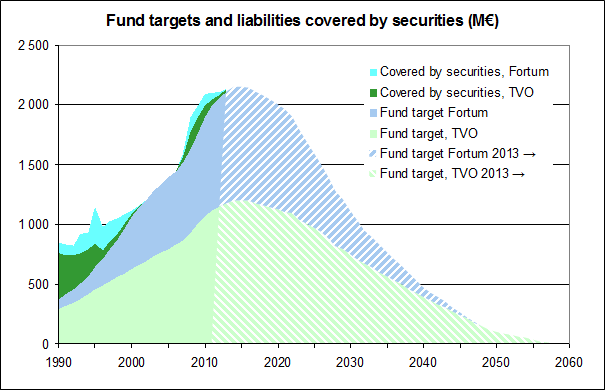
FIG 13. The fund targets (for the 4 existing reactors) in the Nuclear Waste Management Fund and liabilities covered by securities. After 2012 the data are illustrative and take into account both the use of the funds for the implementation and additional inputs until the closing of the reactors(15)
Low- and Intermediate-Level Waste
After treatment, low- and intermediate-level waste generated during the operation of a NPP is initially stored at the plant. After interim storage, the waste is transferred to a repository for low- and intermediate-level waste on the plant site. At Olkiluoto, the disposal of waste in the repository began in 1992 and in Loviisa in 1997.
The repositories for low- and intermediate-level waste are located in the bedrock, at a depth of 60–110 metres. These repositories have separate silos or tunnels for low- and intermediate-level waste, and have been dimensioned to house all radioactive operational waste produced during the operative life of the present Olkiluoto and Loviisa units. Once all waste has been disposed of, the tunnels and shafts leading to the repositories will be filled and sealed.
Interim storage of spent fuel
Spent nuclear fuel from NPPs is stored at the power plant sites until its disposal. In addition to the storage pools in the reactor buildings, the Loviisa NPP has basket type and rack type pool storage attached to the reactor building.
At the Olkiluoto plant, the effective capacity (excluding reserves for repair work) of the pools at the reactor buildings is about 370 tU. Subsequently, the spent fuel is transferred to an on-site facility with three storage pools, the capacity of each being around 400 tU, with high-capacity fuel racks. The spent fuel storage facility was commissioned in 1987 and its current capacity will be adequate until early 2010s. The construction of the extension of the interim storage facility taking into account the storage needs of Olkiluoto 3 unit as well is planned to be completed during 2013.
Spent fuel encapsulation and disposal facility
The amendment to the Nuclear Energy Act in 1994 halted Loviisa NPP's spent fuel shipments to Russia (Chelyabinsk) in 1996. Fortum and TVO agreed on co-operation in nuclear waste management concerning spent fuel treatment and disposal. However, the final responsibility for nuclear waste management stays with the company who produced the waste.
In May 1999, Posiva Oy, which is responsible for the disposal of spent nuclear fuel, filed an application to the Government for a DIP on the construction of a final disposal facility. In May 2001, with a 159–3 majority of votes, the Finnish Parliament ratified the favourable DIP made by the Government in December 2000. The final disposal facility will be built on Olkiluoto, the DIP applying to the spent fuel from Finland’s present four NPP units. In May 2002, in parallel with the decision of the fifth Finnish nuclear unit, Parliament also ratified a new DIP on the final disposal of the spent nuclear fuel of the fifth reactor unit.
Similarly, in spring 2010 a new DIP concerning the disposal of spent fuel from the planned new reactor unit Olkiluoto 4 was made by the Government and ratified by the Parliament on July 1, 2010. Thus, the spent fuel arising from the operation of the Olkiluoto 3 and Olkiluoto 4 reactor units will also be disposed of in the bedrock on Olkiluoto. Posiva Oy submitted a construction licence application for the encapsulation and geological disposal facility to be located in Olkiluoto in the end of 2012. The construction license is expected to be decided by the Government in 2014. The next licensing stage is the application and handling of the application for operation licence. The plan is to start the operation of the facility by the end of 2020.
During their 50 to 60 years in operation, the present Olkiluoto and Loviisa nuclear power units produce at maximum around 4,000 tonnes of spent fuel for final disposal. Spent fuel arising from the Olkiluoto 3 and Olkiluoto 4 units during their 60-year operative lifetime is estimated to total maximum of around 2,500 tonnes each. Consequently, the ratified DIPs for spent fuel arising from the operating reactors as well as from Olkiluoto reactor units 3 and 4 cover in total the disposal of 9,000 tons of spent fuel in the spent fuel disposal facility in Olkiluoto. The encapsulation facility is presently planned to be located at the same location as the underground disposal facility. In the encapsulation facility, the spent fuel rod assemblies are packed into water- and airtight double-layered metal canisters. The fuel rod assemblies at the Olkiluoto and Loviisa reactor units differ in shape and length. However, all of the fuel element types can be packed in copper-cast iron canisters of a similar construction. The canister for Olkiluoto 1&2 is 4.4 metres long, the Loviisa canister 3.4 metres long and the canister for Olkiluoto 3 is 5.2 metres long. The canister diameter in each of these variants is the same.
The encapsulation plant contains a small interim storage for the canisters. Subsequently, the canisters are transferred into the repository, using either a lift with a radiation shield or via the access tunnel with a special vehicle.
The canisters can be positioned either vertically or horizontally in the repository at a depth of around 400 metres. Both options are under investigation. Through the vertical option, the canisters are placed in holes drilled at the bottom of the repository tunnels, spaced a few metres from each other. They are then surrounded with bentonite clay.
When the final disposal canisters have been placed in the repository, the encapsulation plant will be dismantled, the tunnels filled with a mixture of bentonite and crushed rock or with natural clay material, and the shafts leading to the repository closed. The underground repository will require no monitoring after it has been closed. After the facility has been closed and the above-ground structures have been dismantled, the land area can be used for new purposes.
Disposal of spent fuel is planned so that retrievability of the waste canisters is maintained. According to the plans, retrieval is possible at any stage of the final disposal process – including the phase after all the tunnels and shafts have been closed.
The overall time table for the disposal of spent fuel from the Finnish NPPs at Olkiluoto and Loviisa is illustrated in figure 14.
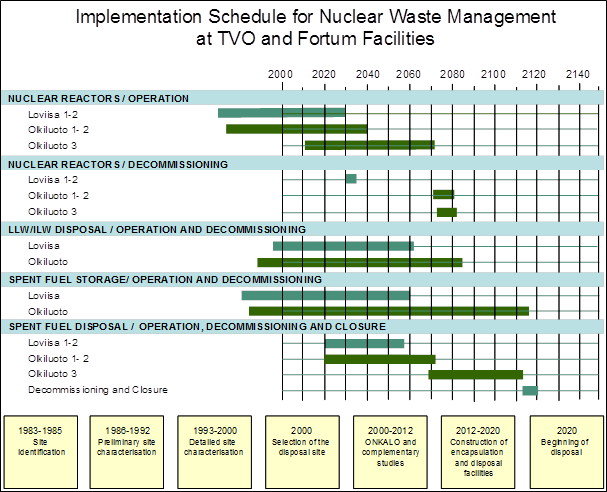
FIG 14. Time table for the disposal of the spent nuclear fuel from the NPPs at Loviisa and Olkiluoto.
Underground Rock Characterization Facility
A deep underground rock characterisation and research facility (ONKALO) is under construction on the Olkiluoto site as part of the site confirmation investigations for spent fuel disposal. The excavation work for the ONKALO facility (figure 15) was begun in September 2004. The excavation works are now nearing completion. Unlike the generic rock laboratories, the ONKALO is being constructed at the actual repository site, and this means that the construction and operation of this facility should not cause major disturbances to the properties of bedrock that are important for the long-term safety. In addition, it should be possible to use the ONKALO later as a part of the repository. This means that the construction of the facility must comply with the rules and requirements applicable for nuclear facilities. Therefore a specific quality assurance programme has been launched for the present activities.
The original design and plans for the underground facility were reported in 2003. Since then a number of changes have been made in the layout of the ONKALO access tunnel, and the number of access shafts has been increased from one to three. Also, the layout and the depth of the auxiliary rooms at the main characterisation level have been updated to match with the current needs.
The main characterisation level is located at the depth of 420 metres, but some of the auxiliary rooms are deeper down at the depth of 437 metres. The excavation work was completed in 2012. The total underground volume of the ONKALO will be approximately 365,000 m³, the combined length of tunnels and shafts being 9.8 km. The access tunnel from the surface to the repository level consists of approximately 4.6 km of tunneling with an inclination of 1:10. The shafts are excavated until the lower level. The personnel shaft will be equipped with a man-cage for personnel transport.
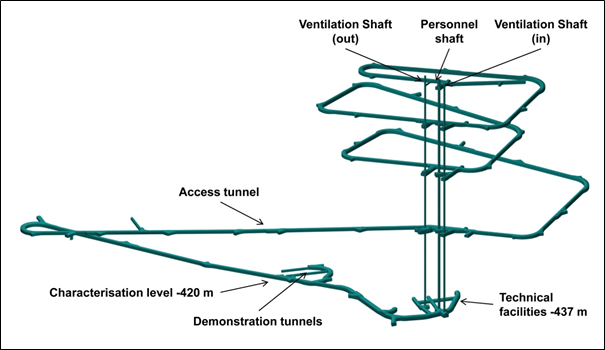
FIG 15. Overall layout of the facility for underground rock characterisation (ONKALO)
Decommissioning: information and plans
No NPPs are currently being decommissioned but the decommissioning of the research reactor FIR-1 will take place this decade. VTT decided to shut down the reactor in 2012. It will take place during the following years.
According to the updated requirements of the Nuclear Energy Act the utilities need to update with six years intervals their technical plans for the decommissioning of the operating reactor units.
The next updates of the decommissioning plans of the utilities will be submitted for regulatory review in 2014. The plan for the Loviisa NPP is based on immediate decommissioning while for the Olkiluoto NPP, a safe storage period of about 30 years prior to dismantling is envisaged. The disposal plans for wastes from decommissioning of the NPPs are based on the extension of the on-site repositories for LILW. Besides dismantling waste, activated metal components accumulated during the operation of the reactors could also be disposed of in those repositories. The engineered barriers will be selected taking account of the radiological and other safety related characteristics of each waste type. A special feature of the decommissioning plans is the emplacement of large components, such as pressure vessels and steam generators, in the disposal rooms as a whole, without cutting them in pieces. The financial liability for future waste management covers decommissioning costs as well.
2.8. Research and development
Finnish nuclear energy research has been decentralised among several research units and groups, which operate at different State research institutes, universities, and in utilities and consulting companies. The focus of nuclear R&D is on the safety and operational performance of the power plants, and the management and disposal of waste. Publicly funded nuclear energy research, on the other hand, provides impartial expertise in nuclear energy issues, contributes to maintaining the necessary personnel and equipment for research and development, and has established a framework for international collaboration.
The annual total funding for Finnish research into nuclear fission and fusion energy is estimated to be around € 75 million (latest update 2010 € 73.5 million). In late 2003, the Nuclear Energy Act was amended to secure funding for long-term nuclear safety and nuclear waste management research in Finland. The necessary financing is collected annually from the licence holders, into two special funds devoted to this purpose. These research funds are aimed at ensuring a high scientific-technical level for national safety research and maintaining national competencies in the long run. For reactor safety research, the amount of finance is proportional to the thermal power of the licensed plant or the thermal power presented in the DIP application or the construction licence application. For waste research, payments are proportional to the fund targets in the Nuclear Waste Management Fund. The total annual volume of these research funds for reactor safety and nuclear waste management is currently (in 2013) almost € 8 million.
The on-going SAFIR2014 safety research programme provides ´a thin coverage´ of all key areas of NPP safety. A new area compared to former programmes is the development and maintenance of research infrastructure. The research programme areas and division of funding for each area is shown in figure 17 and the source of funding in figure 18. Funding from the State Nuclear Waste Management Fund (VYR) for the SAFIR2014 programme has increased to € 5.6 million with DIP concerning Fennovoima’s and TVO’s new NPPs made in July 2010 and the total volume of the programme has increased to a total of approximately € 10 million. The key characteristic of the research programmes with regard to reactor safety is their long-term approach. The project applications for the research programme in 2012 and 2013, however, also took into account the research needs resulting from the Fukushima nuclear accident, in addition to the research needs identified in the framework plan of the programme. The national waste management programme KYT has an annual volume of € 3 million.(16) SAFIR2014 funding areas and sources are introduced in figures 17 and 18.
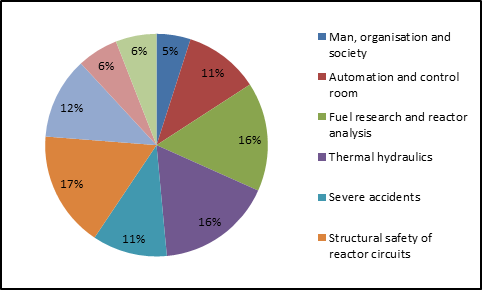
FIG 17. Distribution of funding for various areas of research in the SAFIR2014 programme in 2011
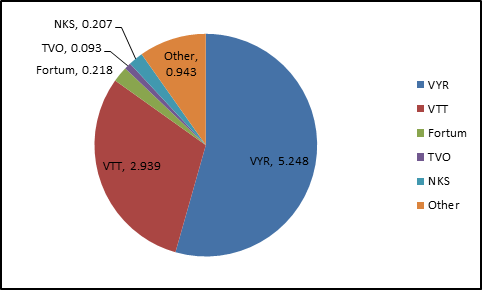
FIG 18. Sources of funding for the SAFIR2014 programme in 2011
VTT Centre for Nuclear Safety
VTT’s main research topics are the characterisation and fracture mechanics of active structural materials (hot cell), radiochemistry, final disposal of nuclear waste, dosimetry and other nuclear technology experimentation, first wall material research for fusion reactors and iodine filter testing. VTT premises for research purposes were built in the 1970s. Old premises suit badly for present operations and VTT is planning new research facilities to be built in Otaniemi, Espoo. Attention has been paid in the design of the premises to adaptability and ease of maintenance. A further aim is to make provision for new experimental research needs that cannot be known at this point. The building expenses at a 2010 cost level would amount to approximately € 36 million. In discussions involving nuclear field actors conducted under the steering of the MEE, decisions were made to cover the additional costs primarily from the research allocations of the State Nuclear Waste Management Fund (VYR), which will need to be temporarily increased through amendments to the nuclear energy legislation.
2.8.1. R&D organizations
Finland has no institutes dedicated solely to nuclear energy research. Most research takes place at VTT. Other major research institutes include the Aalto University and Lappeenranta Technical University (LUT), the Geological Survey of Finland (GTK), the Finnish Meteorological Institute and the universities of Helsinki, Jyväskylä and Tampere. In addition, STUK and the power companies Fortum, TVO and Posiva Oy carry out internal research, or finance research at research institutes or universities. The versatile array of research subjects at research institutes and universities promotes spin-off and spin-in relationships with other industries. Spin-offs include simulation technologies, reliability engineering, fracture mechanics, and non-destructive testing, while spin-in benefits have been enjoyed in areas such as human factors, digital automation systems and computational fluid dynamics (CFD).
2.8.2. Development of advanced nuclear technologies
In 1998, VTT launched a four-year research programme under the name "Advanced Light Water Reactors (ALWR)". At the beginning of the programme, VTT participated in several INNO-cluster projects within the 4th Framework Programme of the European Commission. The largest 4th Framework Programme project included passive safety injection experiments at Lappeenranta University of Technology for the investigation of a passive core make-up tank (CMT). Co-operation with European reactor vendors, Westinghouse Atom and Framatome ANP, started in 1999 and continued in 2000 and 2001 with several projects connected to the new European BWRs, SWR-1000 and BWR90+. The co-operation with TVO and GE on the development of ESBWR also continued. One common feature of the new research projects has been the increasing use of multidimensional CFD codes for the development and evaluation of ALWRs and passive safety systems.
In the area of new generation nuclear reactor systems, VTT has participated in the EU’s framework programme projects under the area of new innovative systems. One example of this is the past project “High Performance Light Water Reactor (HPLWR 1&2)”. In addition, in the KYT2014 research programme, restricted activities are carried out in the area of advanced fuel cycle concepts – primarily the follow-up of research activities on partitioning and transmutation. Based on the initiative of the former Advisory Group on Nuclear Energy (YEN), the research network (GEN4FIN) on advanced nuclear energy systems was established in 2005. The aim of this research network is the further promotion of the maintenance and development of national expertise and international co-operation.
Within the research programme “Sustainable Energy (SusEn)” of the Academy of Finland a joint effort “New Type Nuclear Reactors (NETNUC)” took place during 2008-2011 by a consortium comprising the Finnish Universities of Technology at Lappeenranta and Helsinki (LUT & Aalto University) and VTT (figure 19). Fortum provides additional funding for this joint project. The research work aims to contribute to the validation of the following hypotheses: (1) Key phenomena affecting the safety of new types of reactors are understood thoroughly, enabling the creation of systematic safety criteria that ensure the adequate safety and security of the reactors and fuel cycle facilities (Safety), (2) Advanced reactors and the associated fuel cycles can be developed that utilise more abundant natural isotopes and increase the effectiveness of fuel resource usage and produce less high-level nuclear waste (Sustainability) and (3) New types of reactors can be developed in international cooperation (SCWR, VHTR, GFR, SFR), capable of producing energy effectively and economically for electricity, process heat and hydrogen yields in cogeneration processes (Efficiency).
VTT, TVO, Fortum and the Lappeenranta University of Technology are partners in the Sustainable Nuclear Energy Technology Platform (SNE-TP). The objectives of the platform coincide with many aspects of the NETNUC project. Consequently, SAFIR2014 and NETNUC both contribute to the objectives of SNE-TP, which covers both the present and advanced light-water reactors (e.g. EPR) and fast reactors with closed fuel cycle, which is crucial to the long-term sustainability of nuclear fuel resources. SNE-TP also covers the production of other energy carriers besides electricity. Consequently, participation in this Technology platform ensures close networking with other European stakeholders and research organisations. The NETNUC project has been closely connected with EU projects (e.g. HPLWR2 for the SCWR concept and Raphael for VHTR/GFR gas-cooled concepts) and other global forums. Another important Technology Platform is Implementing Geological Disposal of Radioactive Waste (IGD-TP). The mission of the IGD-TP is to be a tool to support confidence-building in the safety and implementation of deep geological disposal solutions. The vision of IGD-TP is that by 2025, the first geological disposal facilities for spent fuel, high-level waste, and other long-lived radioactive waste will be operating safely in Europe.
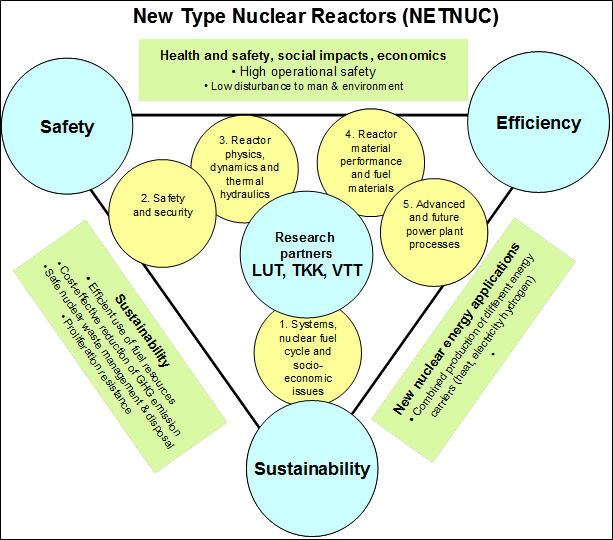
FIG 19. Structure of the NETNUC consortium project with the main research hypotheses and tasks.
2.8.3. International co-operation and initiatives
Finland participates actively in the international co-operation regarding nuclear energy as the development and deployment of the next generation of nuclear power technology is increasingly becoming an international exercise. International collaboration is expected to create considerable efficiencies in developing and deploying new technologies worldwide.
In recent years, the recognition of these trends has led to the development of several multinational initiatives, both for research and other purposes, and call for still more initiatives. Major initiatives now underway or in the early stages of implementation include: the Generation IV International Forum (GIF) led by the USDoE, the International Project on Innovative Nuclear Reactors and Fuel Cycles (INPRO), the Global Nuclear Energy Partnership (GNEP), Multinational Design Evaluation Program (MDEP) and the Multinational Fuel Assurance Concept (MNA) proposed by the International Atomic Energy Agency (IAEA).
At a European level, the latest Nuclear Illustrative Programme (PINC) from 2007 underlined the need to develop common instruments within the framework of nuclear safety. The European Commission has already launched a number of initiatives in the field of nuclear safety, waste management and decommissioning, such as recommendations on the financing of decommissioning activities, the establishment of a Sustainable Nuclear Energy Technology Platform (SNE-TP) and the establishment of the European Nuclear Safety Regulator´s Group (ENSREG) composed of national nuclear regulators for the further development of a common understanding and European rules in the field of nuclear safety and waste management.
As a result, Council Directive 2009/71/Euratom establishing a Community framework for the safety of nuclear installations was given in June 2009. In November 2010, the Commission proposed a Directive on spent fuel and radioactive waste management. On 19 July 2011 the Council adopted the "Radioactive waste and spent fuel management Directive”. The Directive asks Member States to present national programmes, indicating when, where and how they will construct and manage final repositories guaranteeing the highest safety standards. The safety standards become legally binding and enforceable in the European Union. Member States have to submit the first report on the implementation of their national programmes in 2015.(17)
The Sustainable Nuclear Energy Technology Platform (SNE-TP), launched in September 2007, aims at coordinating Research, Development, Demonstration and Deployment (RDD&D) in the field of nuclear fission energy. It gathers together stakeholders from industry, research organisations including Technical Safety Organisations (TSO), universities and national representatives. Regarding joint infrastructures, the recently launched Jules Horowitz Reactor (JHR) material testing reactor project will, in the short term, support studies on generation II and III light water reactors on ageing and life extension, safety and fuel performances, and support material and fuel developments for generation IV reactors. The reactor will be located in Cadarache, France and VTT will be actively involved in the planning and design of this facility.
The Strategic Research Agenda and the Deployment Strategy of SNE-TP reflect a consensus among a large group of stakeholders on research priorities in the field of nuclear fission, addressing the renaissance of nuclear energy with the deployment of generation III reactors, and the development of generation IV systems, both fast neutron reactor systems with fuel multirecycling for sustainable electricity-generating capability and (Very) High Temperature Reactors for other applications, such as the production of hydrogen or biofuels.
Important issues such as the safety of nuclear installations and the responsible management of waste are also addressed, as well as other issues which are crucial to the success of nuclear energy in the 21st century: education and training, research infrastructures, material research and numerical simulation – and funding. The Strategic Research Agenda includes a roadmap for all European nuclear fission research until the year 2040.
In November 2007, the European Commission published the Strategic Energy Technology Plan (SET-Plan). This plan aims at increasing the use of low-carbon technologies to meet the targets set up by the European Council in March 2007 of a 20% / 30% CO2 emission reduction and a 20% renewable increase by 2020. These “Clean” technologies include not only renewables, but also sustainable nuclear fission energy and carbon capture and storage (CCS). The document recognises that nuclear power is a key part of EU energy policy and, alongside other low-CO2 energy sources, contributes to forging the EU’s low-carbon economy.
Besides the activities launched by the Commission, Finnish organisations participate actively in other international efforts furthering the international harmonisation of nuclear safety standards. The bases for this harmonisation should be enhanced co-operation conducted in association with the follow-up conferences on the two important IAEA conventions: the Nuclear Safety Convention and the Joint Convention on the Safety of Spent Fuel Management and on the Safety of Radioactive Waste Management as well as the preparation of Nuclear Safety Guidelines and other documents by the IAEA. Other work currently being performed, such as that by the Western European Nuclear Regulators Association (WENRA), provides a vital additional contribution. In addition, new initiatives such as the Multinational Design Evaluation Programme (MDEP), may contribute to the convergence of national regulatory practices.
2.9. Human resources development
The Nuclear Energy Act was amended in 2003 to es tablish the Nuclear Safety Research Fund. The objective of this Fund is to ensure the high level of national safety research and to maintain the national competence in the long run. A Fund for Nuclear Waste Safety Research was also established, respectively. These funds provide financing for the national research programmes on nuclear fission energy.
The national nuclear safety and waste management research programmes have an important role in the competence building of all essential organizations involved in nuclear energy. These research programmes have two roles: first, ensuring the availability of experts and second, ensuring the on-line transfer of the research results to the organizations participating to the steering of the programmes and fostering expertise. A key objective of the national research programmes on nuclear energy is to train new nuclear experts to meet the requirements for additional human resources owing to the on-going/future operation and the large number of present experts retiring within the next decade. MEE and STUK have important roles in the steering of these programmes.
In 2010, MEE set up a working group to survey long-term needs for nuclear energy field. The survey was carried out by a wide expert group. The final conclusion of the working group in 2012 was the increased need for high-level and wide national know-how in companies, research facilities as well as among authorities. Competence needs in Finland’s nuclear energy sector are growing. The NPP units presently in operation, as well as the Olkiluoto 3 unit under construction, require a competent labour force on a continuous basis. Posiva must have readiness for commencing final disposal of spent fuel by 2020. The new nuclear power projects – TVO’s Olkiluoto 4 and Fennovoima’s NPP, which were given favorable DIPs by the Government in 2010 – will particularly increase the need for experts.
The competence of the licensees as well as the vendor and main subcontractors in one of the key review areas in the licensing processes for the use of radiation and nuclear energy and during the lifetime of the facilities. MEE and STUK are currently updating the legislation and regulatory guides and STUK is going to set goals and requirements on the resources needed to be available for the licensee during normal operation as well as during emergencies.
The licensee has the prime responsibility for ensuring that his employees are qualified and authorised to their jobs. Finnish nuclear power companies have training organizations and training facilities at NPP sites with training staff of around ten persons and full-scope plant-specific training simulators.
Both TVO and Fortum have a systematic approach to training. However, changes in energy markets and the fast development of technology will bring new challenges to the knowledge, and this requires special emphasis of all parties.
There is a basic professional training course (YK) on nuclear safety organized together with the Finnish organizations in the field. The first 6-week course commenced in September 2003 and the 11th basic professional training course will commence in autumn 2013. At the moment, about 600 newcomers and junior experts, of whom about 80 have been from STUK, have participated in these courses. The content and structure of the course has been enhanced according to the feedback received from the participants. Training materials that can be used by the organizations in their internal training programmes are developed as appropriate.
Report of the Committee for Nuclear Energy Competence in Finland
Due to planned expansion of the use of nuclear energy in Finland, a comprehensive study has been conducted in Finland to explore the need of experts and education of experts in Finland to meet the needs from the organizations in the field. The working group study was completed in May 2012. The report is available on:
https://www.tem.fi/files/33402/Report_of_the_Committee_for_Nuclear_Energy_Competence_in_Finland.pdf
2.10. Stakeholder communication
In Finland, the legislation supports wide and deep stakeholder communication when new nuclear facilities are licensed. EIA and Espoo processes includes consultations with stakeholders and the public. All other licensing steps also include extensive statement rounds.
3. NATIONAL LAWS AND REGULATIONS
3.1. Regulatory framework
3.1.1. Regulatory authority/authorities
General safety regulations are issued by the Government. Detailed regulations and regulatory guides are issued by STUK. The licensing of nuclear installations in Finland (construction licence and operation licence) is the responsibility of the Government. A major nuclear facility also needs a positive DIP by the Government, subject to ratification by the Parliament. However, licences for small nuclear facilities (e.g. research reactors with thermal power below 50 MW(e)) are granted by the MEE, which has overall responsibility for control of nuclear energy in Finland.
In Finland, MEE is responsible for the overall supervision of the use of nuclear energy. The drafting of legislation, the implementation of international agreements in Finland, the supervision of the planning and realisation of nuclear waste management, and the administration of the State Nuclear Waste Management Fund constitute a significant part of the Ministry’s duties in the nuclear field. The Ministry supervises research and development work carried out in the field of nuclear safety. Its principal objective is to ensure a high level of safety and operating reliability at existing NPPs and to support the safe and appropriately timed implementation of nuclear waste management. The Ministry represents Finland within the European Atomic Energy Community, the IAEA, the Nuclear Energy Agency (NEA) of the OECD, and the Nordic Nuclear Safety Research Programme (NKS). The Energy Department of the Ministry prepares the Government’s and Ministry’s decrees and decisions on nuclear energy.
STUK is the authority and expert in radiation and nuclear safety in Finland. It interprets requirements laid down by law and supervises their implementation. The objective of STUK’s activities is to maintain Finnish radiation and nuclear safety at a high level and to act as a trendsetter in the development of a safety culture in society in general.
The power company operating a NPP is always responsible for the plant’s safety. It is the duty of STUK to supervise all activities, from the design of the plants to their decommissioning. In this, its objective is to ensure the safety of nuclear facilities so that their operation does not cause a radiation hazard to the health of workers or nearby residents, or other damage to the environment or property. STUK also carried out the national and EU stress tests in Finland after the Fukushima accident.
The key safety and quality target of nuclear safety control is to ensure that the safety level achieved in the use of nuclear energy is maintained, and increased as far as possible, and to contribute to the development of a good safety culture in the use of nuclear energy. These targets are aspired to, for example, by formulating detailed regulations, through the continuous assessment of the safety of operations, and by making inspection visits to the plants.
STUK also supervises Posiva’s research, development and planning work for the final disposal of spent nuclear fuel and the activities of the nuclear power companies in the treatment, storage and final disposal of low- and intermediate-level reactor waste. In addition, STUK controls the safety of the transportation of nuclear waste and radioactive materials.
Furthermore, STUK supervises nuclear materials in order to ensure that they are not used for other than peaceful purposes. Nuclear materials in Finland are also controlled by the European Union and the IAEA.
STUK operates under the auspices of the Ministry of Social Affairs and Health. The safety authority maintains close contacts with the MEE, other government bodies, research institutes, universities and power companies. STUK is assisted by the Advisory Committee on Nuclear Safety (YTN) in major nuclear safety issues and by the Advisory Committee on Nuclear Security.
3.1.2. Licensing process
The decision-making process for the construction of a nuclear facility (e.g. a power plant or a final disposal facility) includes several stages (figure 20). First, the operator carries out EIA on the construction and operation of a nuclear facility. Thereafter, the operator files an application to the Government to obtain a DIP on a new nuclear facility. In case the DIP is affirmed, in due course the operator applies for a construction licence (CL) from the Government. Towards the end of the construction, the operator applies for an operating licence for the facility. After it has received the necessary official statements, the Government decides on whether to issue such an operating licence. The safety aspects of all the licence applications are assessed by STUK.
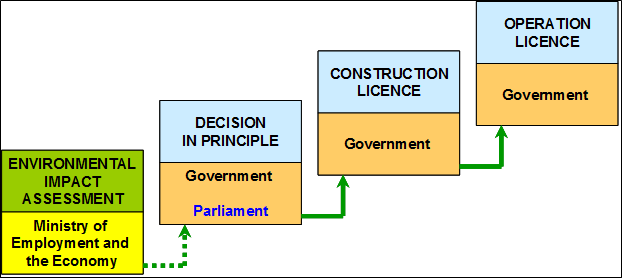
FIG 20. Licensing stages for nuclear facilities in Finland
All use of nuclear energy must meet the following prerequisites:
it shall be generally beneficial for society;
it shall be safe and it shall not cause any detriment to human beings, the environment and property;
physical security, emergency preparedness and other arrangements shall be sufficient to mitigate nuclear accidents and to protect the use of nuclear energy against illegal actions; and
the import of nuclear explosives or the manufacture, possession or exploding of such explosives in Finland is prohibited.
The application for the Government's DIP (see figures 20 & 21) may concern one or more alternative nuclear installation projects. The application shall include as an annex the final report of the EIA procedure conducted according to the requirements set in the corresponding law. In handling the DIP application, the Government requests a preliminary safety appraisal from the STUK and a statement from the municipality intended as the site of the planned nuclear facility.
Before the DIP is made, an overall description of the installation including environmental effects and safety plans are made available to the public. Public and local authorities are given the opportunity to present their opinions in a public hearing. If the general prerequisites are met and if the municipal council of the site in question is in favour (the host municipality has binding right of veto) of the construction of the installation, the Government may make the DIP. The decision is submitted to the Parliament, which either confirms or rejects it (political consideration).
The applications for the construction and operation licences are submitted to the Government. The application for a construction licence is more detailed than the application for the DIP and includes safety analysis reports and security plans. On behalf of the Government, the MEE then asks several statements. The most important one is the statement of the STUK on safety of the facility. The documents to be included in Construction Licence application to be submitted to STUK for approval in this phase are defined in Nuclear Energy Decree § 35. After receiving all statements for the Construction Licence application, the Government will make its decision.
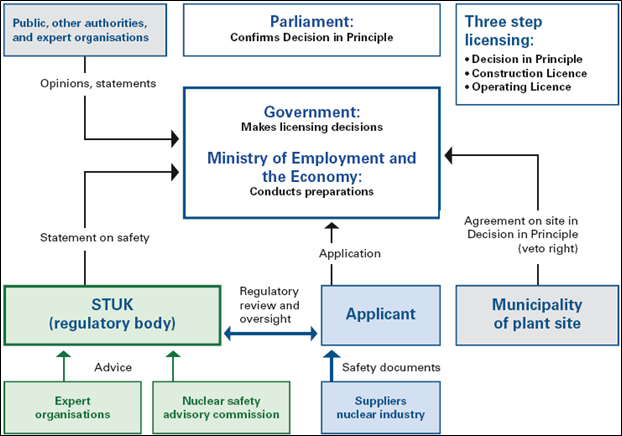
FIG 21. Licensing of nuclear facilities in Finland (e.g. NPPs and nuclear waste management facilities)
The application for an operating licence must be accompanied with detailed construction information of the facility and cover the facility's operation plans. The licence can be granted only for a fixed period.
During the operation, a NPP is subjected to three types of regulatory inspections: periodic inspections; inspections that the operating organisation must pass in order to continue operation; and, continuous re-evaluation of the safety level of the operating plant. Operating licences are granted for a limited period. When renewing a licence, an overall evaluation of the safety of the plant is carried out by STUK.
3.2. Main national laws and regulations in nuclear power
The Nuclear Energy Act (990/1987) and the Nuclear Energy Decree (161/1988) give Parliament final authorisation to permit the building of new major nuclear installations, including final disposal facilities for nuclear waste. The Act and the Decree also define the licensing procedure and conditions for the use of nuclear energy, including waste management, as well as the responsibilities and powers of the authorities. Each producer of nuclear waste in Finland is responsible for the safe handling, management and disposal of waste and for meeting the costs of the related operations. The funds required for future nuclear waste management must be raised gradually during the plant’s operating period.
The requirements provided in the Nuclear Energy Act and Decree are specified in several general regulations laid down by specific Decrees issued by the Government. During 2007–2008, major amendments to legislation related to nuclear energy were prepared. The amended Nuclear Energy Act is in force since June 2008 after the approval by the Parliament. The amended Nuclear Energy Decree has been in force since December 2008. The main reason for the changes has been the requirement under the amended constitutional law that certain key requirements be presented within the Nuclear Energy Act in place of the previous practice, based on which many of these requirements were set in lower level regulations, such as Government decisions. These decisions have now since December 2008 been replaced by Decrees issued by the Government. Also after 2008 there have been additional minor changes in the legislation.
The detailed Finnish licensing requirements for nuclear installations are outlined in the STUK regulatory guidelines (YVL Guidelines). The YVL guides have included more than 70 guidelines in the following eight series: general guides, systems, pressure vessels, civil engineering, equipment and components, nuclear materials, radiation protection and radioactive waste management. An amendment process for these regulatory guides is now underway and both the general structure of the guideline system and the topics and number of individual regulatory guidelines are undergoing major changes. The aim is to complete this amendment process by the end of 2013.
The Radiation Act (592/1991) establishes the conditions for preventing and limiting the harmful effects of radiation on the health of workers and the general public. The latest amendments to the Radiation Act and Decree were made at the end of 2005, to reflect the EU Directive on the control of high activity sealed radioactive sources.
The Nuclear Liability Act (484/1972 & 588/1994) implements the Paris Convention on the Third Party Liability in the Field of Nuclear Energy and the Brussels Supplementary Convention. Furthermore, the amendment of 1994 adopts the Joint Protocol bridging the Paris and Vienna Conventions. Due to the negotiations for the updating of the Paris and Brussels Conventions on Nuclear Liability and their successful completion in early 2004, the Finnish Nuclear Liability Act was also reviewed. The review process began with the examination of amendments required by a special governmental committee and was followed by the drafting of a bill to amend the Nuclear Liability Act by the Government. The bill was approved by Parliament in the spring of 2005. These amendments include unlimited financial liability to licensees and a requirement that the licensee have to acquire insurance to cover damages up to € 700 million. The entry into force of this bill has been pending the ratification by the Parties of the 2004 Protocol to Amend the Paris Convention. Meanwhile, the Finnish Parliament has approved amendments to the law, increasing the amount of insured damages up to € 700 million and introducing unlimited financial liability nationally. These amendments came into force in 2012.
The Act on Environmental Impact Assessment (468/1994) provides that EIA be compulsory for nuclear facilities.
Several other laws under general legislation also affect nuclear power production, e.g.:
The Electricity Market Act (386/1995) opened up access to distribution networks and allows foreign ownership in electricity supply.
The Act on Competition Restrictions (480/1992) is compatible with the EC law on competition.
The Land Use and Building Act (132/1999) requires a land use plan for power plants and other facilities to be built on plant sites and provides guidelines for their planning.
The Environmental Protection Act (86/2000) lays down various requirements relating to environmental protection.
Completely revised Mining Act has been accepted by the Parliament on 15 March, 2011 and entered into force in 2011.
The requirements presented in the Nuclear Energy Act and Decree are specified in several general regulations laid down by the Decrees of the Government. These Decrees cover the following topic areas:
General safety regulations for nuclear power plants (733/2008);
General regulations concerning the physical protection in the use of nuclear energy (734/2008);
General regulations concerning emergency preparedness for nuclear power plants (735/2008);
Safety of the final disposal of nuclear wastes (736/2008).
APPENDIX 1: INTERNATIONAL, MULTILATERAL AND BILATERAL AGREEMENTS
Finland is a member state, e.g. of the following intergovernmental organisations:
International Atomic Energy Agency (since 1958)
Nuclear Energy Agency of the OECD (since 1976)
International Energy Agency (since 1992)
APPENDIX 2: MAIN ORGANIZATIONS, INSTITUTIONS AND COMPANIES INVOLVED IN NUCLEAR POWER RELATED ACTIVITIES
(7) VTT Technical Research Centre of Finland – Nuclear Energy in Finland, National Survey Paper 2013
(16) MEE - Report of the Committee for Nuclear Energy Competence in Finland

